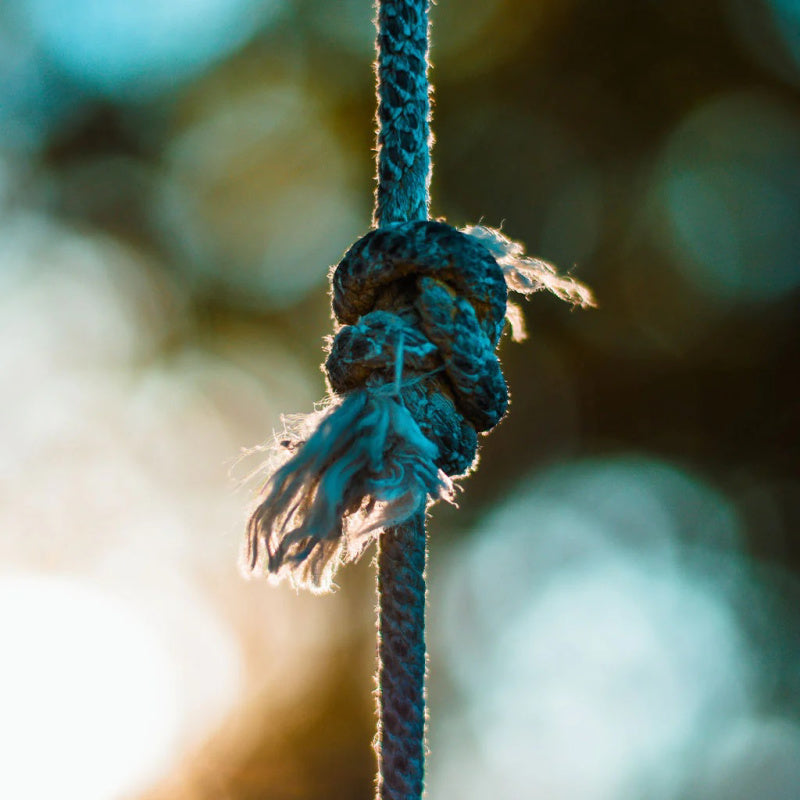
7 Crucial Camping Knots That Could Save your Life
Learning knots for survival can truly be a lifesaver! Imagine being able to secure shelter, create tools, or even save someone's life with just a piece of rope and a few well-learned knots.
It's empowering to know that you have the skills to handle unexpected situations confidently.
Each knot you learn is like adding a tool to your survival kit, giving you the ability to adapt and overcome challenges in any environment.
So keep practicing, keep learning, and remember that every knot mastered brings you one step closer to being prepared for whatever life throws your way!
Check out these 7 knots that are simple yet incredible effective and have been used for thousands of years!
Square Knot (Reef Knot):

Use: Joining two ropes of equal diameter.
How to Tie: Cross the ropes, left over right, then right over left, forming a square knot.
Maritime Usage:
The square knot gained prominence among sailors and seafarers due to its versatility and reliability. It was commonly used aboard ships for securing sails, rigging, and cargo. The knot's ability to join two ropes securely made it invaluable in maritime contexts, where safety and stability were paramount.
Clove Hitch:

Use: Securing a rope to a post or tree.
How to Tie: Loop the rope around the object, then cross it over itself to create a half hitch. Repeat once more, resulting in two opposing half hitches.
Symbolism and Tradition:
In addition to its practical applications, the clove hitch has acquired symbolic significance in some cultures. In nautical traditions, it is associated with concepts such as seamanship, craftsmanship, and teamwork. The knot's distinctive appearance and ease of tying have also made it a popular choice for decorative and ceremonial purposes.
Bowline:

Use: Creating a secure loop at the end of a rope.
How to Tie: Form a small loop near the end of the rope, pass the working end through the loop, around the standing end, and back down through the loop.
Cultural Influence:
The bowline knot has left its mark on literature, folklore, and popular culture, appearing in stories, songs, and legends around the world. Its distinctive shape and historical significance have made it a symbol of strength, resilience, and seamanship in many cultures.
Taut-Line Hitch:

Use: Adjustable knot for securing a line under tension.
How to Tie: Wrap the rope around an object, then make two turns around the standing part of the rope. Pass the working end between the object and the turns, then wrap it around the standing part and through the loop created.
Scouting and Camping:
The taught-line hitch gained widespread recognition and usage through organizations like the Boy Scouts of America and other scouting groups around the world. Scouting manuals and instructional materials often include the taught-line hitch as an essential knot for securing tents, tarps, and other camping equipment.
Sheet Bend:

How to Tie: Create a bight in the larger rope, pass the smaller rope through the bight, wrap it around the bight, and tuck it under itself.
Origins in Seafaring:
Like many other knots, the sheet bend likely emerged among sailors and seafarers who needed a reliable method to join two ropes of different diameters. Its ability to securely bind ropes together while still allowing for easy adjustment made it invaluable in maritime contexts.
Prusik Knot:

Use: Creating a sliding loop for attaching a rope to another rope or a fixed line.
How to Tie: Form a loop with a smaller-diameter rope and wrap it around a larger rope. Pass the loop through itself and tighten.
Continued Relevance:
Despite advances in climbing and rescue technology, the Prusik knot remains a fundamental tool for climbers, rescuers, and rope technicians. Its simplicity, reliability, and versatility make it an essential component of any climber's toolkit and a cornerstone of technical rope work in vertical environments.
Figure Eight Knot:

Use: Creating a stopper knot at the end of a rope.
How to Tie: Form a loop and pass the working end through the loop, around the standing end, and back down through the loop to create a figure-eight shape.
Fishing and Net Making:
Fishermen also relied on the figure-eight knot for various purposes, including attaching hooks, swivels, and lures to fishing lines. The knot's ability to create a secure loop at the end of a line made it well-suited for angling and net making, where strong and reliable connections are essential.
Mastering these knots will provide you with a solid foundation for various bushcraft tasks and enhance your wilderness survival skills. Practice tying them until you can do so confidently and quickly, as knot tying proficiency is invaluable in outdoor situations.

